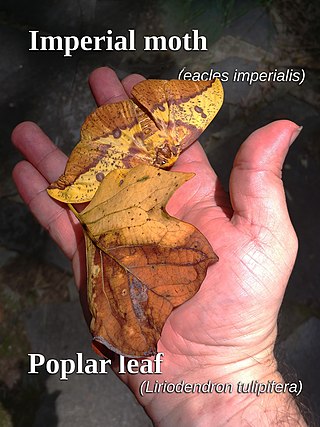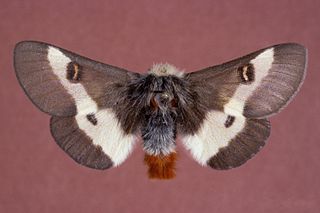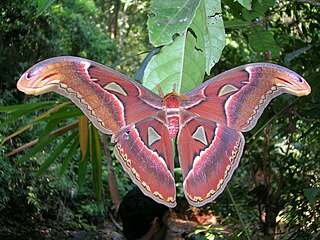
Moths are a group of insects that includes all members of the order Lepidoptera that are not butterflies. They were previously classified as suborder Heterocera, but the group is paraphyletic with respect to butterflies and neither subordinate taxa are used in modern classifications. Moths make up the vast majority of the order. There are thought to be approximately 160,000 species of moth, many of which have yet to be described. Most species of moth are nocturnal, although there are also crepuscular and diurnal species.

Saturniidae, members of which are commonly named the saturniids, is a family of Lepidoptera with an estimated 2,300 described species. The family contains some of the largest species of moths in the world. Notable members include the emperor moths, royal moths, and giant silk moths.

Saturnia pavonia, the small emperor moth, is a moth of the family Saturniidae. It was first described by Carl Linnaeus in his 1758 10th edition of Systema Naturae. Sometimes, the incorrect genus name Pavonia is still used for this species. This moth occurs throughout the Palearctic region and is the only member of its family to be found in the British Isles, where it is usually called simply the emperor moth.

Eacles imperialis, the imperial moth, is a member of the family Saturniidae and subfamily Ceratocampinae. It is found mainly in the East of South America and North America, from the center of Argentina to south Canada. The species was first described by Dru Drury in 1773.

Eacles is a genus of moths in the family Saturniidae. They are native to the Americas. The genus was erected by Jacob Hübner in 1819.

The buck moth is a common insect found in oak forests, stretching in the United States from peninsular Florida to New England, and as far west as Texas and Kansas. It was first described by Dru Drury in 1773. The larvae typically emerge in a single generation in the spring. The larvae are covered in hollow spines that are attached to a poison sac. The poison can cause symptoms ranging from stinging, itching and burning sensations to nausea. Subspecies Hemileuca maia maia is listed as endangered in the US state of Connecticut.

Saturnia is a genus of large moths in the family Saturniidae, which the German biologist Franz Paula von Schrank first described in 1802. Its members are commonly named emperor moths, though this is also used for various close relatives in subfamily Saturniinae. Most species are Palearctic, but three, commonly called saturnia moths, inhabit the chaparral of California: S. mendocino, S. walterorum, and S. albofasciata.

The dryandra moth is a species of moth that is considered to be the sole member of the family Carthaeidae. Its closest relatives are the Saturniidae and it bears a resemblance to many species of that family, bearing prominent eyespots on all wings. The common name is derived from the Dryandra shrubs of the genus Banksia, on which the larva of this species feed, and is hence restricted to the south-west of Western Australia where these shrubs grow. Other Grevillea shrubs may also be used as host plants.

The Saturniinae or saturniines are a subfamily of the family Saturniidae. They are commonly known as emperor moths or wild silk moths. They are easily spotted by the eyespots on the upper surface of their wings. Some exhibit realistic eye-like markings, whilst others have adapted the eyespots to form crescent moon or angular shapes or have lost their wing scales to create transparent windows. They are medium to very large moths, with adult wingspans ranging from 7.5 to 15 cm, in some cases even more. They consist of some of the largest sized Lepidoptera, such as the luna moth, atlas moth, and many more. The Saturniinae is an important source of wild silk and human food in many different cultures.

Coscinocera hercules, the Hercules moth, is a moth of the family Saturniidae, endemic to New Guinea and northern Australia. The species was first described by William Henry Miskin in 1876.

Syntherata janetta is a moth of the family Saturniidae, commonly known as the emperor moth.

Attacus is a genus of moths in the family Saturniidae. The genus was named by Carl Linnaeus in his 1767 12th edition of Systema Naturae.

Opodiphthera is a genus of moths from the family Saturniidae that are endemic to Australia.
Neodiphthera is a genus of moths in the family Saturniidae. It was described by David Stephen Fletcher in 1982.

Syntherata is a genus of moths in the family Saturniidae first described by Peter Maassen in 1873.